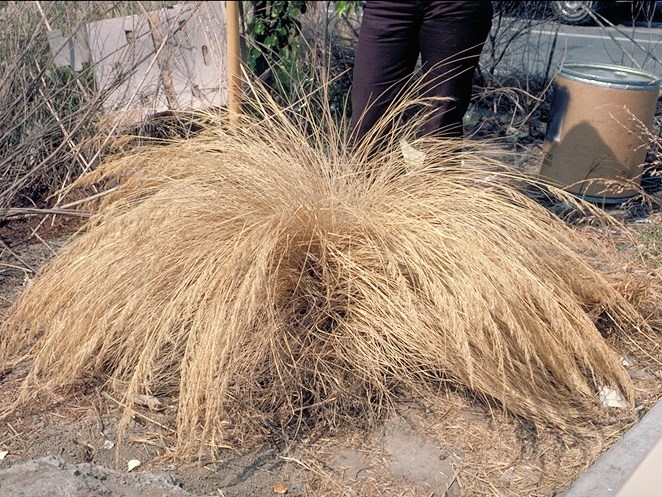Created by: Elizabeth D. Brusati
Created on: Monday, Jan 25th, 2016
Created on: Monday, Jan 25th, 2016
Yes or No:
Yes
Points:
1
Confidence Level:
Very High
Answer / Justification:
California and Australia
Reference(s):
Yes or No:
Yes
Points:
2
Confidence Level:
Very High
Answer / Justification:
Naturalized in 9 counties in California.
Reference(s):
Yes or No:
Yes
Points:
2
Confidence Level:
High
Answer / Justification:
Listed as invasive in South Australia, Western Australia and Tasmania due to its effects on agriculture and pasture. Listed under synonym Stipa brachyaeta in Parsons and Cuthbertson, which says that it invades disturbed soils along roadsides, waste places, and streams, and run-down pastures. Answering no because does not seem to have impacts in natural areas.
Reference(s):
Yes or No:
Yes
Points:
3
Confidence Level:
Medium
Answer / Justification:
Listed as invasive in South Australia, Western Australia and Tasmania due to its effects on agriculture and pasture. There are few locations in the Australian Herbarium, none from South Australia. The one point from Western Australia (Perth) matches California's climate. Confidence lower due to lack of information on where it's invasive.
Reference(s):
Yes or No:
Yes
Points:
1
Confidence Level:
Very High
Answer / Justification:
If you consider genus Stipa (its synonym), yes. Stipa capensis invasive in California. Other species of Stipa are invasive in Australia.
Reference(s):
Yes or No:
Yes
Points:
2
Confidence Level:
High
Answer / Justification:
Has a limited natural and invasive range but as most of the locations in Australia match California, I am answering yes. Native to Argentina.
Reference(s):
Yes or No:
No
Points:
0
Confidence Level:
High
Answer / Justification:
Invades disturbed sites or alfalfa fields in California, so not really affecting natural areas. A weed of overgrazed pasture, agricultural, and disturbed sites in Australia.
Reference(s):
Yes or No:
No
Points:
0
Confidence Level:
Medium
Answer / Justification:
No mention of this in any references.
Reference(s):
Yes or No:
Yes
Points:
1
Confidence Level:
Medium
Answer / Justification:
Foliage unpalatable to livestock. In Australia, can seriously reduce the productivity of pastures. However, the references seem to indicate that it mostly invades pastures that are already poor quality.
Reference(s):
Yes or No:
No
Points:
0
Confidence Level:
Medium
Answer / Justification:
Grows up to 1m or occasionally 1.5 m tall but no information on how dense it is or whether it creates "impenetrable" areas.
Reference(s):
Yes or No:
No
Points:
0
Confidence Level:
Very High
Answer / Justification:
Reproduces by seed. No mention of any vegetative reproduction. Does not have creeping rhizomes.
Reference(s):
Yes or No:
No
Points:
0
Confidence Level:
High
Answer / Justification:
Reproduces by seed. No mention of any vegetative reproduction.
Reference(s):
Yes or No:
Yes
Points:
1
Confidence Level:
Very High
Answer / Justification:
Reproduces by seed.
Reference(s):
Yes or No:
Yes
Points:
1
Confidence Level:
Medium
Answer / Justification:
This species produces two types of seeds, chasmogamous (with pollination) and cleistogamous (self-pollinating). Lerner found that mature tillers of punagrass can produce 250 chasmogamous seeds and low (<20) numbers of cleistogamous seeds each. 30% of tillers had chasmogamous seeds. She also found that plants produced a mean 1215 to 1619 cleistogamous seeds (lower number in poor conditions; higher in good conditions). This is difficult to translate into simple numbers because her studies were comparing plants derived from the two types of seeds. However, based on these numbers, I'm answering yes.
Reference(s):
Yes or No:
Yes
Points:
1
Confidence Level:
Medium
Answer / Justification:
Seeds germinate in autumn and grow over winter (Australia). Lerner tested dormancy breaking treatments on seeds (after a chilling experiment) and found low germination rates with or without the treatments (25% or lower). However, she cited another study that found 40% germination for the chasmogamous seeds falling on the soil surface.
Reference(s):
Yes or No:
Yes
Points:
1
Confidence Level:
High
Answer / Justification:
Since it's a grass, it seems likely that it would produce seed within three years.
Reference(s):
Yes or No:
Yes
Points:
1
Confidence Level:
Medium
Answer / Justification:
Flowers May to October in California. Could not find information on seed production. In Australia, flowering starts in late spring and continues through summer if moisture is available. Interpreting these together as a yes.
Reference(s):
Yes or No:
Yes
Points:
1
Confidence Level:
Very High
Answer / Justification:
Cross-pollinated seeds are often dispersed after their awns become attached to animals, clothing, or vehicles. Fine hairs on awns and callus allow seeds to stick to wool, clothing, and other material.
Reference(s):
Yes or No:
Yes
Points:
1
Confidence Level:
Medium
Answer / Justification:
Dispersed by water, particularly during floods. However, Parsons and Cuthbertson says that water is a minor component of dispersal.
Reference(s):
Yes or No:
Yes
Points:
1
Confidence Level:
Very High
Answer / Justification:
Awns attach to vehicles. Can also be spread by mowing or in contaminated agricultural products. Fine hairs on awns and callus allow seeds to stick to wool, clothing, and other material.
Reference(s):
In both California and Australia, this species is a weed of agricultural crops or highly disturbed areas. Invades mostly overgrazed pastures in Australia.
Direct link to Weeds of Australia evaluation (under a synonym): http://keyserver.lucidcentral.org/weeds/data/03030800-0b07-490a-8d04-060...
- < 13 : accept (low risk of invasiveness)
- 13 - 15 : evaluate further
- > 15 : reject (high risk of invasiveness)
PRE Score:
20
Number of questions answered:
20
Screener Confidence (%):
79.0
Organization:
Evaluation visibility:
Public - accessible to all site users

